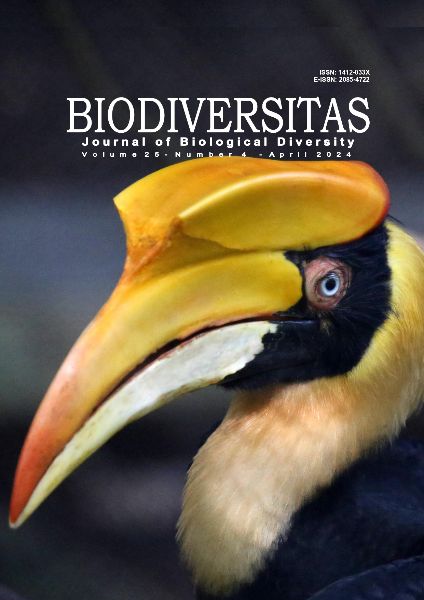Diversity of Salacca zalacca (Gaertn.) Voss from Bali, Indonesia based on morphological and molecular characters
##plugins.themes.bootstrap3.article.main##
Abstract
Abstract. Sumantra IK, Listihani L, Ariati PEP. 2024. Diversity of Salacca zalacca (Gaertn.) Voss from Bali, Indonesia based on morphological and molecular characters. Biodiversitas 25: 1771-1780. There are several salak (Salacca zalacca (Gaertn.) Voss) variations based on epicarp (skin) color, pulp aroma, and taste. The different characters are not only found among different production centers, but also among plants cultivated in the same area. This study aimed to identify the morphological and molecular characters of 16 salak cultivars from Bali, Indonesia. Morphological characters were described based on the individual test guideline for salak species and molecular characters were analyzed using four Random Amplified Polymorphic DNA (RAPD) primers, namely OPA3, OPC7, OPD4, and OPD20. The morphological characters of 16 salak cultivars are very diverse in plant height, number of leaflets, leaflets length and width, leaf sheath length, fruit skin color, fruit shape, fruit length, fruit diameter, number of fruits per bunch, number of seeds per fruit, and thick pulp. A total of 37 DNA bands ranging from 250-4000 bp was obtained and 28 bands of which are polymorphic. The dendrogram formed 4 clusters. Cluster 1 consists of Bingin, Kelapa, Gulapasir, Nangka, Muani, Gonong, Penyalin, Gondok, Layu, Sudamala, Merah, Jaka, and Putih salak cultivars. Cluster 2 consists of Pada cultivar, cluster 3 consists of Injin cultivar, and cluster 4 consists of Nenas cultivar. This research is the first diversity analysis report on S. zalacca from Bali based on morphological and molecular characters.
##plugins.themes.bootstrap3.article.details##
Most read articles by the same author(s)
- HERMANU TRIWIDODO, LISTIHANI, High impact of PGPR on biostatistic of Aphis craccivora (Hemiptera: Aphididae) on yardlong bean , Biodiversitas Journal of Biological Diversity: Vol. 21 No. 9 (2020)
- NI PUTU PANDAWANI, LISTIHANI LISTIHANI, I KETUT WIDNYANA, PUTU EKA PASMIDI ARIATI, DEWA GEDE WIRYANGGA SELANGGA, High impact of Clerodendrum paniculatum leaf extract to suppress zucchini yellow mosaic virus infection in zucchini plants , Biodiversitas Journal of Biological Diversity: Vol. 23 No. 6 (2022)
- DEWA GEDE WIRYANGGA SELANGGA, LISTIHANI LISTIHANI, I GEDE RAI MAYA TEMAJA, GUSTI NGURAH ALIT SUSANTA WIRYA, I PUTU SUDIARTA, KETUT AYU YULIADHI, Determinants of symptom variation of Pepper yellow leaf curl Indonesia virus in bell pepper and its spread by Bemisia tabaci , Biodiversitas Journal of Biological Diversity: Vol. 24 No. 2 (2023)
- RUDI TOMSON HUTASOIT, MUHAMMAD JIHAD, LISTIHANI LISTIHANI, DEWA GEDE WIRYANGGA SELANGGA, The relationship between vector insect populations, natural enemies, and disease incidence of tungro virus during wet and dry seasons , Biodiversitas Journal of Biological Diversity: Vol. 24 No. 7 (2023)
- EKA SUNARWIDHI PRASEDYA, FITRIANI FITRIANI, PUTU BELLA APRILLIA SARASWATI, NIRWANA HAQIQI, WANDA QORIASMADILLAH, HIKMATURROHMI HIKMATURROHMI , SITI ZAINIAH NURHIDAYATI, PUTU EKA PASMIDI ARIATI, Evaluation of bioprospecting potential of epiphytic Gracilaria edulis harvested from seaweed farm in Seriwe Bay, Lombok, Indonesia , Biodiversitas Journal of Biological Diversity: Vol. 24 No. 10 (2023)
- LISTIHANI LISTIHANI, PUTU EKA PASMIDI ARIATI, I GUSTI AYU DIAH YUNITI, DEWA GEDE WIRYANGGA SELANGGA, The brown planthopper (Nilaparvata lugens) attack and its genetic diversity on rice in Bali, Indonesia , Biodiversitas Journal of Biological Diversity: Vol. 23 No. 9 (2022)
- I GEDE RAI MAYA TEMAJA, DEWA GEDE WIRYANGGA SELANGGA, TRISNA AGUNG PHABIOLA, KHAMDAN KHALIMI, LISTIHANI LISTIHANI, Relationship between viruliferous Bemisia tabaci population and disease incidence of Pepper yellow leaf curl Indonesia virus in chili pepper , Biodiversitas Journal of Biological Diversity: Vol. 23 No. 10 (2022)
- LISTIHANI LISTIHANI, I GUSTI AYU DIAH YUNITI, PUTU EKA PASMIDI ARIATI, NI PUTU PANDAWANI, DEWA GEDE WIRYANGGA SELANGGA, I GEDE RAI MAYA TEMAJA, GUSTI NGURAH ALIT SUSANTA WIRYA, I PUTU SUDIARTA, Beneficial interaction between rice stunt virus and its insect vector Nilaparvata lugens Stal based on life table , Biodiversitas Journal of Biological Diversity: Vol. 24 No. 8 (2023)
- GUSTI NGURAH ALIT SUSANTA WIRYA, DEWA GEDE WIRYANGGA SELANGGA, LISTIHANI LISTIHANI, I GEDE RAI MAYA TEMAJA, I PUTU SUDIARTA, Molecular characterization of Sweet potato feathery mottle virus and sweet potato yield loss due to its infection , Biodiversitas Journal of Biological Diversity: Vol. 25 No. 6 (2024)

